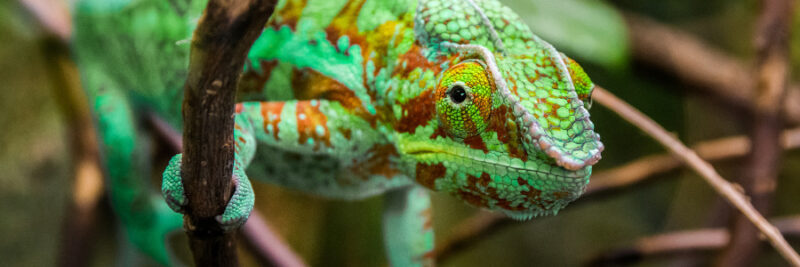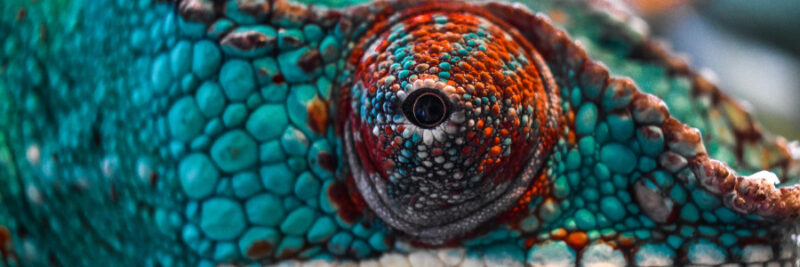Welcome new panther chameleon owners! This introductory guide covers everything you need to know to properly care for these incredible colorful lizards. While their specialized needs can seem daunting at first, having the right habitat, heat, hydration and nutrition will set you up for success. Let’s explore setting up your new companion to thrive!
Getting Started with Panther Chameleons

Native to Madagascar’s tropical forests, panther chameleons are most known for their striking colors, incredible length up to 20 inches, independently moving eyes, projecting tongues and color changing abilities. While their care is complex, they make good starter chameleons when commitments are made to meet their needs.
Constructing Proper Terrariums
As arboreal lizards, panthers require ample vertical space with specific heating, lighting and decor.
Sizing and Materials
House juveniles in 18 x 18 x 24” screened tanks, upgrading adults to a minimum of 24 x 24 x 36”. Front opening construction is ideal for accessibility.
Ambient Heating and Lighting
Use overhead ceramic heat emitters to create a 95°F basking area while ambient temperatures reach 78-82°F. Pair with Reptisun 5.0 UVB fluorescent tubes for healthy bones and skin.
Thriving Rainforest Replications
Use 3-4” of orchid bark or sphagnum moss substrate to hold humidity between 60-80%. Include ample foliage, vines and branches for climbing and security. Mist twice daily.
Providing Nutritious Diets

In captivity, provide a variety of appropriately supplemented insects.
Whole Prey Options
Feed size-appropriate gut loaded crickets, worms, small roaches and occasional treats including hornworms, silkworms and Dubia roaches.
Balancing Essential Nutrients
Lightly coat insects with ZooMed Repti-Calcium and ReptiVite multivitamins to provide calcium for strong bones and additional nutrients they may not get otherwise from whole prey diets alone.
Respectful and Responsible Handling
While panthers rarely enjoy frequent handling, gentle short positive sessions build trust over time.
Constructive Care Connections
Allow a few weeks after arrival before initiating 10-15 minute handling periods 2-3 times per week, fully supporting the body at all times and avoiding grabbing tails. Go slowly and remain calm.
Hydration Habits
Hydrate your panther chameleon by misting the enclosure 1-2 times per day. Ensure water droplets accumulate on leaves and branches throughout their habitat for them to lick off.
Avoiding Health Issues

Stay vigilant for signs of illness and partner with an exotic vet.
Recognizing Problems Early
Look for unusual discoloration, shedding issues, changes in appetite or energy signaling problems requiring attention. Act quickly!
Establishing Specialized Veterinary Care
Find qualified herp vets you can develop long term relationships with to optimize chances of successful treatment.
Frequently Asked Beginner Panther Chameleon Questions
While more demanding than beginner geckos, panthers can make good starter chameleons with research and dedication to their specific care needs for heat, humidity and hydration.
Focus on proper lighting, temperatures ranging 78-95°F, water provisions through misting, 60-80% humidity, a habitat with ample climbing foliage, and calcium plus multivitamin supplemented gut loaded insects.
An 18 x 18 x 24” minimum screen enclosure while juveniles, upgrading to 24 x 24 x 36” for adults, overhead ceramic heat emitter, T5 UVB lighting, vines and plants, a reliable misting system, and gut loaded/supplemented crickets, worms and small feeder roaches.
Panther chameleons generally do not enjoy frequent handling. Limit contact to brief, gentle sessions allowing them to walk on your hands while fully supporting their body as they choose to build trust and monitor their health.
I hope this guide supports your success caring for and bonding with panther chameleons! Let me know if you have any other beginner questions.
